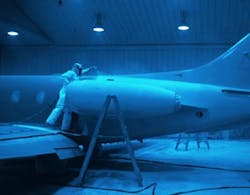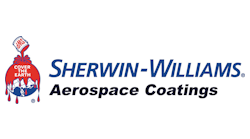When it comes to aircraft detailing, there’s more to the overall process than just adding decorative striping, waxing, or buffing it to a gleaming sheen.
Comprehensive detailing is the end result that encompasses everything from precise painting to cleaning to proper scheduled maintenance — all factors that not only make a plane look good but also keep it aerodynamic and flight ready.
Detailing 101
Good detailing can occur at any stage of the aircraft maintenance schedule, from the routine, monthly A-Check to the all-important D-Check (the latter occurring every five years or so). This includes several key steps:
First, inspect the aircraft for any signs of leakage, abrasion, and paint erosion and repair any leaks as necessary. Fluid leakage affects the integrity of existing coating systems by softening and hampering their protective abilities, and is a leading factor in long-term coating deterioration.
Next, use a high quality cleaner on fluid stains, oxidation across the body, or carbon that frequently builds up close to the engines. After spot cleaning, the aircraft should be cleaned thoroughly, inside and out.
Examining the condition of existing paint is another key step. If any paint has eroded, a repaint might be needed prior to the final steps of waxing and polishing, even if an aircraft is relatively new. The need for repainting depends on the condition of the previous coating system, how it was applied, and the quality of the materials used.
The importance of paint
An aircraft’s paint system plays a number of important roles. It gives the aircraft a distinct aesthetic, promotes brand identity, and provides crucial protection against corrosion and other damage to its aluminum structure.
A high-quality aircraft coating system consists of one coat of primer and at least two coats of a topcoat. Like any strong structure, the paint topcoat is only as good as its foundation. New, durable primer/surfacer combinations should always be used, and some are now available free of lead and chrome hazards. These low-VOC, two-component, corrosion-inhibitive products provide faster priming and surfacing on all types of aircraft while also providing key environmental benefits. Such primers contribute to the reduction of the permissible exposure limit (PEL) for hexavalent chromium (CR(VI)) that meets the Occupational Safety and Health Administration’s (OSHA) latest standard for occupation exposure to this chemical.
Using this kind of product allows paint technicians to first apply it as a primer, sand, and then spray on the same product again as a surfacer. This eliminates the need to discard unused product and re-mix another, saving significant time and labor.
Topcoat technology has also evolved as high-solids, multi-component polyester urethane systems now offer fast dry and cure times to improve both shop processing flow and productivity. These systems offer excellent coverage and protection for most types of aircraft. Notable features of such systems include excellent flow and leveling, good buffing characteristics, blister resistance, and six- to eight-hour cure times. Some of these coatings offer chemical resistance to a variety of substances, including Skydrol and other hydraulic fluids — delivering superior hiding and stain resistance, as well as outstanding gloss and gloss retention upon weathering.
Stripping tips
Coatings play a critical role in operation of an aircraft. A dull finish can affect aerodynamics and glide. Too many layers of old paint add weight and can affect speed and performance, overall weight allowance, and fuel efficiency. Almost nothing is more expensive than jet fuel, and the aviation industry is working to conserve fuel and money anywhere it can. This includes eliminating weight created by paint.
Weight allowance considerations obviously factor heavily in the decision to either repaint an aircraft over existing coating system layers, or strip the plane completely down to its aluminum skin and give it an entirely new, fresh paint job.
If it is discovered in early service checks that an aircraft’s finish has suffered paint erosion (and if the plane has only been repainted one time in addition to its OEM coating), then in most cases it’s not necessary to completely strip off all existing paint. Instead, painters can abrade the existing coatings on the plane to create a rough coat and apply a new system over the abraded layer.
Planes that have had at least two repaints should be completely stripped and repainted, no matter how new the aircraft is. This is a common occurrence with leased planes that change owners (and paint schemes) every couple of years.
The age of the aircraft also determines if paint should be abraded or stripped. Older planes should be stripped at the time of the intensive D-Check (roughly every five years) and be examined closely for corrosion.
During the stripping process, the aircraft should be washed thoroughly with environmentally friendly cleaners to remove all dirt and debris from the surface and then should dry completely before the next steps. Fragile surfaces should be protected with aluminum masking materials, while paper masking tape is suitable for standard masking uses. Paint strippers work best under warm conditions, so it’s best to allow the airframe and hangar to reach temperatures close to 75 F before starting work. Use airless spray applicators and nonferrous scrapers to avoid damaging the thin protective layer of aluminum clad on the aircraft’s skin.
After this work is completed, then begin the aforementioned surface preparation steps and complete the project with the appropriate topcoat color and clear layers.
A regular paint regimen is a must in an aircraft’s maintenance program. A fresh paint job enhances the aesthetics of any aircraft, boosts image and branding of the company that owns the plane, and, more importantly, protects the aircraft’s surfaces from wear, tear, and corrosion.
J. Marc Taylor is Director of Sales with Sherwin-Williams Aerospace Coatings, www.sherwinwilliams.com/aerospace.






